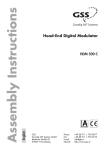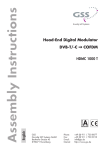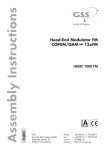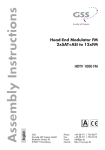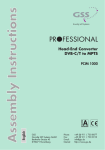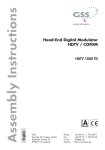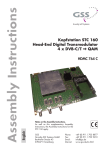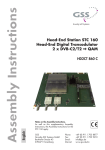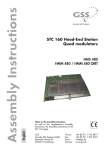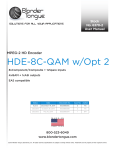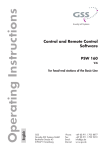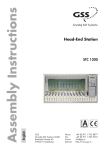Download User Manual
Transcript
Head-End 5 to 1 Multiplexer 5xASI/IP to 1xASI/MPTS KLASSE HADA 5100 English CLASS GSS Grundig SAT Systems GmbH Beuthener Strasse 43 D-90471 Nuremberg Phone: Fax: E-mail: Internet: +49 (0) 911 / 703 8877 +49 (0) 911 / 703 9210 [email protected] http://www.gss.de Contents 1 Safety regulations and notes............................................................................... 4 2 General information........................................................................................... 5 2.1 Packing contents.................................................................................... 5 2.2 Meaning of the symbols used.................................................................. 5 2.3 Technical data....................................................................................... 5 2.4 Description........................................................................................... 6 2.5 Software query...................................................................................... 7 3 Assembly........................................................................................................... 8 3.1 Installing the cassette.............................................................................. 8 3.2 EMC regulations.................................................................................... 9 3.3 Cassette overview................................................................................ 10 3.4 Connecting the cassette........................................................................ 10 4 The control panel at a glance............................................................................ 11 4.1 Menu items......................................................................................... 11 4.2 Control panel...................................................................................... 11 5 Programming................................................................................................... 12 5.1 Programming procedure............................................................................12 5.2 Programming the cassette..................................................................... 15 Selecting the cassette........................................................................ 15 Ethernet parameters.......................................................................... 16 Hardware IP address........................................................................ 16 Address range................................................................................. 17 Address of the gateway.................................................................... 17 UDP port......................................................................................... 18 Output parameters............................................................................ 18 ASI transmission rate......................................................................... 19 ASI options........................................................................................ 19 Output IP address............................................................................. 20 Switching the IP address off or on....................................................... 21 Transmission protocol........................................................................ 21 Port number..................................................................................... 21 Quantity of data packets................................................................... 22 Forward error correction................................................................... 22 Transmission channel........................................................................ 22 Input parameters.............................................................................. 23 Signal source................................................................................... 23 Switching the IP address off or on....................................................... 24 Transmission protocol........................................................................ 24 Port number..................................................................................... 24 Input IP addresses............................................................................. 25 - 2 - HADA 5100 Station filter..................................................................................... 25 Manually selection............................................................................ 26 Hint for the Service IDs...................................................................... 27 Transport stream / ORGNET-ID.......................................................... 28 Output data rate............................................................................... 28 Factory reset.................................................................................... 29 Saving settings................................................................................. 29 6 Final procedures............................................................................................... 30 - 3 - HADA 5100 1 Safety regulations and notes • Assembly, installation and servicing should be carried out by authorised electricians. • Switch off the operating voltage of the system before beginning with assembly or service work or pull out the mains plug. • Do not perform installation and service work during thunderstorms. • Install the system so it will not be able to vibrate… - in a dust-free, dry environment - in such a manner that it is protected from moisture, fumes, splashing water and dampness - somewhere protected from direct sunlight - not within the immediate vicinity of heat sources - in an ambient temperature of 0 °C to +50 °C. In case of the formation of condensation wait until the system is completely dried. • Ensure that the head-end station is adequately ventilated. Do not cover the ventilation slots. • Beware of short circuits • No liability is accepted for any damage caused by faulty connections or inappropriate handling. • Observe the relevant standards, regulations and guidelines on the installation and operation of antenna systems. • The standards IEC/EN/DIN EN 50083 and IEC/EN/DIN EN 60728 must be observed. • For further information please read the assembly instructions for the headend station used. • Test the software versions of the head-end station and the cassette and update them if necessary. The current software versions can be found at ”www.gss.de”. Take action to prevent static discharge when working on the device! Electronic devices should never be disposed of in the household rubbish. In accordance with directive 2002/96/EC of the European Parliament and the European Council from January 27, 2003 which addresses old electronic and electrical devices, such devices must be disposed of at a designated collection facility. At the end of its service life, please take your device to one of these public collection facilities for proper disposal. - 4 - HADA 5100 2 General information 2.1 Packing contents 1 Cassette HADA 5100 6 BNC cable 2.2 Meaning of the symbols used 1 LAN cable 1 Brief assembly instructions Important note —> General note • 2.3 Technical data The devices meet the following EU directives: 2006/95/EC, 2004/108/EC The product fulfils the guidelines and standards for CE labelling. Unless otherwise noted all values are specified as “typical”. LAN interface Standard:..............................................................10-BASE-T, IEEE 802.3i 100-BASE-TX, IEEE 802.3u 1000-BASE-X , IEEE 802.3z Data rate:...............................................................................≤ 180 MBit Protocols:........................................................... UDP (User Data Protocol), RTP (Real-Time Transport Protocol) ASI interfaces Standard:......................................................................DIN EN 50083-9 Format:.................................................................MPEG ISO IEC 13818-1 User data rate:.................................................................. 2 … 90 Mbit/s Impedance:..................................................................................... 75 Ω Max. data rate:.......................................................................180 MBit/s Level (input / output):.......................................................800 mVPP ± 10% Return loss (input):................................................ > 17 dB (5 … 270 MHz) Performing works - 5 - HADA 5100 Connections LAN:................................................................................. 1 RJ 45 socket ASI inputs:............................................................... 5 BNC sockets, 75 Ω ASI output:.................................................................1 BNC socket, 75 Ω Connection strip (10-pin):....................for supply voltages and control circuits RS 232 socket:...................................... serial interface for software update 2.4 Description The cassette is a 5 to 1 multiplexer. It converts 5 ASI/SPTS/MPTS input channels into one ASI/MPTS output channel. Each input channel has (selectively) one ASI input (ASI – Asynchronous Serial Interface according to DIN EN 50083-9) and one LAN interface (1 input IP address). The fed in transport streams can be edited individually and will be combined into one transport stream in the TPS module. This transport stream is emitted at the ASI output or the LAN interface (1 output IP address). For operating the cassette in a LAN network it can be assigned its own hardware IP address. —> Two IP address ranges are used: "Hardware" IP addresses (menu ETHERNET), which are used to connect the cassettes in the network (e.g. 192.168.0.x). "IPTV" IP addresses (menus OUT-IP, IP-INPUT), which are used to send and receive the IPTV channels (multicast range e.g. 227.40.50.x). Principle signal path: LAN1: 227.40.50.1 ASI input 1 LAN 2: 227.40.50.2 ASI input 2 LAN 6: 227.40.50.6 LAN 3: 227.40.50.3 ASI input 3 TPS ASI output LAN 4: 227.40.50.4 ASI input 4 LAN 5: 227.40.50.5 ASI input 5 - 6 - HADA 5100 The cassette is controlled with the head-end station control unit. The LEDs for the LAN interface show whether a network connection exists and whether a data transfer is in progress. When the head-end station is switched on, the two-line LC display shows the software version of the control unit. To operate this cassette the software version of the control unit must be “V 42” or higher. You can find the current operating software for the control unit and the cassette, the software “BE-Flash” and the current assembly instructions on the website “www.gss.de”. The cassette is designed for use in the following head-end stations: STC 1200, STC 816 and PST 19-1. Five LEDs (6, nal is present: 8, 0, @, $) indicate by their colour whether an input sigLED colour Green Red 123 4 56 78 90 !@ #$ % ^ 2.5 Software query Control unit If necessary, you can activate the indication of the software version of the control unit manually: • Press any two keys on the control unit of the head-end station simultaneously until the display goes dark and the software version, e.g. “V 42” appears. Indication Signal present no Signal Cassette After activating the cassette the software version of the cassette is displayed (see page 15). - 7 - HADA 5100 3 Assembly 3.1 Installing the cassette – Ensure the head-end station is mounted so it will not be able to vibrate. Avoid, for example, mounting the head-end station onto a lift shaft or any other wall or floor construction that vibrates in a similar way. – Before installing or changing a cassette unplug the power cable from the mains power socket. • Remove the fastening screws 1 of an unoccupied slot from the bracket of the head-end station. • Insert the cassette in this slot and push it into the housing. • Align the cassette and apply slight pressure to connect it to the connections of the board and the HF bus bar. • Fasten the cassette with the screws 1. 1 ACHTUNG! Vor dem Cassettenwechsel unbedingt Netzstecker ziehen! CASSETTE CASSETTE CASSETTE CASSETTE CASSETTE CASSETTE CASSETTE CASSETTE CASSETTE CASSETTE CASSETTE CASSETTE 0° MESSAUSGANG KLASSE CAUTION! Before changing cassettes remove mains plug! A CLASS 1 - 8 - HADA 5100 3.2 EMC regulations KLASSE CLASS To comply with the current EMC regulations, it is necessary to connect the lines leading in and out of the head-end station using cable terminals. When mounting the cassette in a head-end station which is installed in a 19” cabinet, make sure the connections leading in and out for the 19” cabinet are made using cable terminals. The attenuation of shielding of the connection lines for ASI and antenna must meet the requirements for “Class A”. • Insert the required number of cable terminals in the openings provided in the head-end station or in the 19” cabinet. Tighten the nuts on the cable terminals until the teeth on the lock washer have penetrated the exterior coating and a good connection is made between the housing and cable terminals. - 9 - HADA 5100 3.3 Cassette overview 123 4 1 2 3 4 5 6 7 8 9 0 ! @ # $ % 56 78 90 !@ #$ % ^ Status LED of the LAN interface (data transfer) LAN socket Status LED of the LAN interface (network connection) ASI output ASI input 5 Status LED ASI input 5 ASI input 4 Status LED ASI input 4 ASI input 3 Status LED ASI input 3 ASI input 2 Status LED ASI input 2 ASI input 1 Status LED ASI input 1 D-SUB socket “RS 232“ —> The operating software of the cassette can be updated via the 9-pin D-SUB socket “RS 232” using a PC or notebook and the software “BE-Flash”. You can find the current operating software on the website "www.gss.de". ^ 3.4 Connecting the cassette • Connect the LAN socket 2. • Connect the ASI inputs 5, 7, peripheral ASI devices. Type label + MAC address 9, !, # and the ASI output 4 to the - 10 - HADA 5100 4 The control panel at a glance 4.1 Menu items Programme the cassette using the buttons on the control unit of the head-end station. The two-line display of the control unit then shows the menus. The parameters and functions to be set are underlined. Use the key to select the following main menu items: – Ethernet parameter – Output parameter – Input parameter – Transport stream and ORGNET-ID – Displaying the data rate – Factory reset 4.2 Control panel The key pad on the head-end station is used to scroll through the menus: V42 please wait . . . scrolls forward through the menus. select parameters in the menus. set values, initiate actions. selects sub-menus. scrolls backward through the menus. saves all entries. BE-Remote - 11 - HADA 5100 5 Programming 5.1 Programming procedure Ein / On BE–Remote V 42 please wait … t > 10 s Box 1 …… ……… …… + Box 4 Bx 1A TWIN-SAT Böx 4 TWIN-SAT Box 5 …… C5-12,S3-24 C07 C5-12,S3-24 C07 ……… …… TS-MUX V1 0.128 – – – A B Bx 4 stat ETHERNET => Options ▶ Bx 4 IP-ADDR 192.168. 0.128 Page 14 ◀/▶ stat / DHCP Bx 4 IP-MASK 255.255.255. Bx 4 IP-GATEWAY 192.168. Bx 4 0. ◀/▶ 0 ◀/▶ 1 UDP-PORT ◀/▶ 60000 0 … 65535 nur bei Auswahl "ASI" only with selection "ASI" Bx 4 ASI OUTPUT => ▶ ASI RATE ◀/▶ 108000 KBits ASI/LAN ASI OPTION 188 pos. cont. - 12 - ◀ / ▶ 188 / 204 positiv / negativ, positive / negative HADA 5100 kontinuierlich / burst, continuous / burst ASI/LAN ASI OPTION 188 ◀ / ▶ 188 / 204 positiv / negativ, positive / negative kontinuierlich / burst, continuous / burst pos. cont. nur bei Auswahl "LAN" only with selection "LAN" OUT-IP 227. 40. 50. 6 MODE / PORT on 1234 UDP PKTS / FEC 7 ◀/▶ ◀ / ▶ on / off UDP / RTP, 0 … 65535 ◀ / ▶ off / 10/9 … 20/19 Annex A / Annex B off 1…7 1 …5 Bx 4 INPUT 1 LAN OK => ▶ IN 1 INPUT LAN ASI / LAN INFO: ASI/LAN – – –/OK nur bei Auswahl "LAN" only with selection "LAN" IN 1 on MODE / PORT UDP IN 1 227. 1234 IP-INPUT 40. IN 1 50. 1 ◀ / ▶ on / off UDP / RTP, 0 … 65535 ◀/▶ FILTER first / all / cascaded / manual all IN 1 TV ± 001/016 Das Erste - 13 - nur bei Auswahl "manual" only with selection "manual" ◀/▶ HADA 5100 first / all / cascaded / manual all ◀/▶ Das Erste ◀/▶ Bx 4 nur bei Auswahl "manual" only with selection "manual" TV ± 001/016 IN 1 TS/ONID 0x0001,0100 Bx 4 DATARATE 087/180 Page 12 Bx 4 FACTORY Defaults => ▶ Bx 4 FACTORY STORE => M A M B Page 12 - 14 - HADA 5100 5.2 Programming the cassette —> Pressing the button for longer than 2 seconds cancels the programming procedure. This takes you back to the program item “Selecting the cassette” from any menu. Any entries that have not been saved are reset to the previous settings. —> Entries in the menus can be saved by pressing the key. You are taken back to the “Selecting the cassette” menu item. —> Pressing the button returns to the previous menus. • Switch on the head-end station Ein / On BE–Remote V 42 please wait … t > 10 s —> The display shows the software version (e.g. V 42) —> The processor reads the cassettes‘ data (approx. 10 seconds). Selecting the cassette Box 1 …… ……… …… + Box 4 V1 Bx 1A TWIN-SAT Böx 4 TWIN-SAT Box 5 …… C5-12,S3-24 C07 C5-12,S3-24 C07 ……… …… TS-MUX 0.128 – – – • Select the cassette you want to program (e.g. Box 4) by repeatedly pressing the button if necessary. —> The display shows e.g. the menu"Box 4 TS-MUX": "Box 4" stands for slot 4, "TS-MUX" type of cassette "V 1" software version of the cassette 192.168."0.128" hardware IP address of the cassette - 15 - HADA 5100 • Press the button. —> The "Ethernet parameters" – "ETHERNET" main menu is activated. Ethernet parameters In this menu you specify whether the Ethernet parameters for the cassette are entered automatically by a connected server (“DHCP”), or whether you want to enter them manually (“stat”). —> To assign the cassette uniquely, each IPTV cassette must be allocated its own IP address. Bx 4 stat ETHERNET => Options —> To skip the setting of the Ethernet parameter press the button. The "Output parameters" – "OUTPUT" main menu is activated (page 18). • Press the buttons to select manual setting (”stat”) or automatic setting (”DHCP”) of the Ethernet parameters. • Press the button to activate the setting options (”Options”). —> The “Hardware IP address” – “IP-ADDR” sub menu is activated. Hardware IP address To operate the cassette in a network, an IP address must be assigned to each IPTV cassette. If a manually setting of the Ethernet parameters is selected, set the IP address of the cassette in this menu. If “DHCP” is selected, the “IP-ADDR”, “IP-MASK” and “IP-GATEWAY” sub-menus display the parameters that were assigned automatically by a connected DHCP server, e.g. “192.168. 0.128*”. The star “ * ” in the display means that the data is provided by a DHCP server. If no server is connected, “ 0. 0. 0. 0” appears in the corresponding menu. Bx 4 IP-ADDR 192.168. 0.128 - 16 - HADA 5100 • Use the buttons to place the cursor under the digit of the IP address displayed to be set and use to set the IP address wished. • Press the button. —> The “Address range” – “IP-MASK” sub menu is activated. Address range In this menu you define the address range for the cassettes connected to the LAN network. Bx 4 IP-MASK 255.255.255. 0 • Use the buttons to place the cursor under the digit of the IP mask displayed to be set and use to set the IP mask wished. • Press the button. —> The “Address of the gateway” – “IP-GATEWAY” sub menu is activated. Address of the gateway The address of a gateway (server/router) can be set in this menu. If no gateway is used you can skip this setting. Bx 4 IP-GATEWAY 192.168. 0. 1 • Use the buttons to place the cursor under the digit of the IP address displayed to be set and use to set the IP address wished. • Press the button. —> The “UDP port” – “UDP-PORT” sub menu is activated. - 17 - HADA 5100 UDP port The UDP port setting is required if the cassette shall be controlled via remote access and the standard port 60000 can not be used. Bx 4 UDP-PORT 60000 • Use the buttons to place the cursor under the digit of the port number displayed to be set and use to set the port number wished (”0” … ”65535”). • Press the button. —> The "Output parameters" – "OUTPUT" main menu is activated. Output parameters In this menu you select whether you whish to output the output transport stream via the ASI output or the LAN. In addition you can set the output parameters in the submenus. Bx 4 ASI • Use the OUTPUT Bx 4 OUTPUT => LAN => buttons to select the output wished ("ASI" or "LAN"). —> To skip the settings of the output parameters press the button. The "Input parameters" – "INPUT" main menu is activated (page 23). • Press the button. —> If "ASI" is selected, the "ASI transmission rate" – "ASI RATE" submenu is activated. —> If "LAN" is selected, the "Output IP address" – "OUT-IP" submenu is activated (page 20). - 18 - HADA 5100 ASI transmission rate In this menu you set the output transmission rate for the ASI component connected. For this setting please take the required information from the documentation (technical data) of the ASI component to be connected. ASI RATE 108000 KBits • Use the buttons to place the cursor under the digits to be set for the transmission rate then use the buttons to set the transmission rate wished. • Press the button. —> The “ASI options” – “ASI OPTION” sub menu is activated. ASI options In this menu you define the size of the data packets, their polarity and the type of transmission. For this setting please take the required information from the documentation (technical data) of the ASI component to be connected. ASI OPTION 188 pos. cont. • Press the bits). buttons to set the size of the data packets (“188” or “204” • If the polarity of the data to be transmitted has to be changed, press the buttons to place the cursor under “pos.” (positive – standard) and using the buttons set to “neg.” (negative). • To change the type of transmission press the buttons to position the cursor under “cont.” (continuous – standard) and using the set to “burst”. —> Setting “cont.” The data packets of the user data are collected to a great data packet in the transport stream. - 19 - HADA 5100 —> Setting “burst” The data packets of the user data are spaced out evenly in the transport stream. • Press the button. —> You will be returned to the “Output parameters” – “OUTPUT” main menu (page 18). Output IP address In this menu you set the IP address for the IP output. OUT-IP 227. 40. 50. 6 —> Use an IP address of the multicast range (e.g. 227.40.50.x). • Press the buttons to position the cursor under the digit of the IP address to be set. • Using the buttons set the IP address wished. • Press the button. —> The “Switching the IP address off or on, transmission protocol, port number” – “MODE / PORT” submenu is activated. - 20 - HADA 5100 Switching the IP address off or on Transmission protocol Port number In this menu you can switch off the IP address displayed, and define the transmission protocol and the port number. MODE / PORT on UDP 1234 Switching the IP address off or on • Press the buttons to switch off (”off”) or (“on”) the IP address and the service referred. Selecting the transmission protocol • Press the button to position the cursor under ”UDP”. • Using the buttons to select the transmission protocol wished: —> "UDP"– The User Datagram Protocol is for the connectionless transmission of data without acknowledgement from the receiver. "RTP" – The Real-time Transport Protocol additional transmits time informations for runtime error correction at receiver side. Setting the port number • Press the button to position the cursor under the port number e.g. ” 1234”. • Use the buttons to position the cursor under the digit of the port number displayed to be set. • Using the buttons set the port number wished. • Press the button. —> The “Quantity of data packets, Forward error correction, Transmission channel” – “PKTS / FEC” submenu is activated. - 21 - HADA 5100 Quantity of data packets Forward error correction Transmission channel In this menu you set the quantity of the data packets to be transmitted, the forward error correction FEC and the transmission channel. If the forward error correction is used additional redundant data are transmitted, so that the addressee can correct transmission errors. PKTS / FEC 7 off Defining the quantity of data packets • Using the buttons define the quantity of MPEG data packets in one IP data packet (”1” … ”7”). —> Setting ”7” results the smallest overhead. Setting the forward error correction • Press the button to position the cursor under ”off” . —> In position ”off” the forward error correction (FEC) is switched off. • Using the ”20/19”). buttons set the value of the FEC wished (”off, 10/9” … PKTS / FEC 7 10/09 AnnexB Setting the transmission channel • Press the button to position the cursor under ”Annex…”. • Use the buttons to set the transmission channel wished (”AnnexA” / ”AnnexB”). • Press the button. —> You will be returned to the “Output parameters” – “OUTPUT” main menu (page 18). • Press the button. —> The "Input parameters" – "INPUT" main menu is activated. - 22 - HADA 5100 Input parameters In this menu you select the input, for which you would like to set the input parameters in the submenus. Bx 4 INPUT 1 LAN OK => —> The indications "LAN" and "OK" serve for information: LAN - LAN is already set for input 1. OK - input signal is present at input 1. • Use the buttons to select the input ("1" … "5"), for which you would like to set the input parameters. —> To skip the settings of the input parameters press the button. The "Transport stream and ORGNET-ID" – "TS/ONID" main menu is activated (page 27). • Press the button. —> The "Signal source" – "IN x INPUT" submenu is activated. Signal source In this menu you select the signal source wished for the selected input. IN 1 LAN • Use the INPUT IN 2 INPUT ASI buttons to select the signal source wished ("LAN" or "ASI"). —> If "ASI" is selected, the "Station filter" – "IN x Filter" submenu is activated (page 25). —> If "LAN" is selected, the "Switching the IP address off or on, Transmission protocol, Port number" – "IN x MODE / PORT" submenu is activated. - 23 - HADA 5100 Switching the IP address off or on Transmission protocol Port number In this menu you can switch off the IP address displayed, and define the transmission protocol and the port number. MODE / PORT on UDP 1234 Switching the IP address off or on • Press the buttons to switch off (”off”) or (“on”) the IP address and the service referred. Selecting the transmission protocol • Press the button to position the cursor under ”UDP”. • Using the buttons to select the transmission protocol wished: —> "UDP" – The User Datagram Protocol is for the connectionless transmission of data without acknowledgement from the receiver. "RTP" – The Real-time Transport Protocol additional transmits time informations for runtime error correction at receiver side. Setting the port number • Press the button to position the cursor under the port number e.g. ” 1234”. • Use the buttons to position the cursor under the digit of the port number displayed to be set. • Using the buttons set the port number wished. • Press the button. —> The "Input IP addresses" – "IN x IP-INPUT" submenu is activated. - 24 - HADA 5100 Input IP addresses In this menu you set the IP address for the IP input selected. IN 1 227. IP-INPUT 40. 50. 1 —> Use an IP address of the multicast range (e.g. 227.40.50.x). • Press the buttons to position the cursor under the digit of the IP address to be set. • Using the buttons set the IP address wished. • Press the button. —> The "Station filter" – "IN x Filter" submenu is activated. Station filter In this menu you select the stations (services) of the input transport stream which shall be used. IN 1 FILTER all • Use the buttons to select the option wished. —> "all" - all stations are used. "cascaded" - setting for the "downstreamed" HADA 5100 when using several HADA 5100 cascaded – observe the following hints about the service IDs (SIDs) as well as chapter "cascading" (page 31). "first" - only the first station of the transport stream is used. "manual" - the additional submenu "Manually selection" will be displayed next. - 25 - HADA 5100 Hints about the service IDs Service IDs (SID) New SIDs will be assigned to the selected services. At settings "all", "first" und "manual" the assignment of the SIDs is done "dynamically" according to the following scheme : Input 1 - services 1 … 64—> SIDs 101 … 164 Input 2 - services 1 … 64—> SIDs 201 … 264 Input 3 - services 1 … 64—> SIDs 301 … 364 Input 4 - services 1 … 64—> SIDs 401 … 464 Input 5 - services 1 … 64—> SIDs 501 … 564 —> If more than 64 services per input are selected, this "overflow" is assigned from SID 601 upwards. —> At setting "cascaded" the assignment of the SIDs is done "statically". Therefore an example is shown in chapter "cascading" page 31. • Press the button. —> Is "all", "cascaded" or "first" selected, you will be returned to the “Input parameters” – “INPUT” main menu (page 23). —> Is "manual" selected, The "Manually selection" – "IN x xxx/yyy" submenu is activated. - 26 - HADA 5100 Manually selection In this menu you select the stations (services) of the input transport stream which shall be used. IN 1 TV ± 001/016 Das Erste —> All stations (Services) of the input transport stream will be read, and then displayed with name and station type. —> If no station is found, the following message will appear in the display: “FILTER no Service”. In this case, check the configuration of the antenna system and headend station, as well as the previously adjusted settings for the cassette and the components connected to the ASI/LAN input. —> The display shows e.g.: IN 1 TV + 001/016 Das Erste Meaning of the indicators in the example: "IN 1" Number of the selected input "TV" Station type "Television" "+" The currently selected station is activated. "001/016" The 1st of 10 stations is being displayed. "Das Erste" Station name Further possible terms displayed: "RA" Radio channel type For radio stations, the background of the screen of the connected TV or test receiver is darkened. "—" The currently selected station is deactivated. "HD" HD reception —> If a service number (e.g. “131”) appears instead of “TV” or “RA”, this indicates that an unnamed station or an undefined data stream is being received. • Use the “ – ”). buttons to call up the stations in sequential order, then use to activate (indicated by “ + ”) or to deactivate them (indicated by - 27 - HADA 5100 If no station is found, the display shows "– – –" instead of the station name. In this case, check the previously adjusted settings for the cassette and the components connected to the ASI/LAN input. • Press the button. —> You will be returned to the “Input parameters” – “INPUT” main menu (page 23). —> If necessary set further inputs. • Press the button. —> The “Transport stream / ORGNET-ID” – “TS/ONID” main menu is activated. - 28 - HADA 5100 Transport stream / ORGNET-ID If the stations (services) of several transponders are merged to one transport stream, a new identification (ORGNET-ID) must be allocated to the transport stream, to realise the channel search of the settop boxes connected without mistakes. Bx 4 TS/ONID 0x0001,0100 • Use the buttons to position the cursor under the digit of the hexadecimal number to be set. • Press to set the respective digit of the hexadecimal number. • Repeat the procedure by the quantity of the digits to be set. • Press the button. —> The "Output data rate" – "DATARATE" main menu is activated. Output data rate In this menu the current output data rate is displayed. Bx 4 DATARATE 087/180 —> "087" - current data rate. "180" - maximum data rate —> The maximum Data rate depends on the used/available output: – 1 GBit LAN - 180 MBit – 100 MBit LAN - 80 MBit – ASI - ASI RATE setting (page 19) • Press the button. —> The "Factory reset" – "FACTORY" main menu is activated. - 29 - HADA 5100 Factory reset In this menu you can reset all settings to the factory defaults. Bx 4 FACTORY Defaults => ▶ Bx 4 FACTORY STORE => M A M B • Press the button. —> The submenu “FACTORY STORE” is invoked. —> By pressing the button, you will be returned to the menu item “Ethernet parameters” – “ETHERNET” without invoking the factory defaults (page 16). • Press the button. —> The factory defaults are saved. The display shows “STORE” —> Back to “Selecting the cassette” (page 15). —> By pressing the button, you will be returned to the menu item “Ethernet parameters” – “ETHERNET” without invoking the factory defaults (page 16). Saving settings • Press the button. —> Back to “Selecting the cassette” (page 24). —> The settings are saved. - 30 - HADA 5100 Cascading If several HADA 5100 are cascaded, at the "downstreamed" cassette (cassette 6 of the example) the station filter (page 25) must be set to "cascaded". Cascading, for example, is used to combine many transport streams each containing one service to one transport stream. Service 01…05 SID101,201,301,401,501 SID101,201,301,401,501 SID101,201,301,401,501 SID101,201,301,401,501 Service 21…25 SID101,201,301,401,501 Service 16…20 Service 06…10 06 07 08 09 10 "downstreamed" Service 11…15 Service Service Service Service Service 01 02 03 04 05 Cassette 2 Service Service Service Service Service Cassette 1 Example: "upstreamed" Cassette 6 Service 01…25 SID SID SID SID SID 101…105 201…205 301…305 401…405 501…505 Cassette 3 Cassette 4 Cassette 5 At setting "cascaded" the assignment of the SIDs is done "statically", so that the SIDs of the services at the output of the "downstreamed" cassette (6) will not change, if the input signal of one input of the "upstreamed" cassettes (1…5) is discontinued. "Static" SID assignment at setting "cascaded" (for cassette 6 of the example): Input 300 400 Input SID SID at the output 101 101 201 301 401 201 102 202 302 402 301 103 203 303 403 401 104 204 304 404 501 105 205 305 405 Example: SID 301 at input 2 —> SID 203 at the output 100 200 - 31 - 500 501 502 503 504 505 HADA 5100 Table for "static" SID assignment at station filter setting "cascaded" 100 Input SID 101 102 103 104 105 106 201 202 203 204 205 206 301 302 303 304 305 306 401 402 403 404 405 406 501 502 503 504 505 506 101 111 121 131 141 151 102 112 122 132 142 152 103 113 123 133 143 153 104 114 124 134 144 154 105 115 125 135 145 155 Input 200 300 400 SID at the output 201 301 401 211 311 411 221 321 421 231 331 431 241 341 441 251 351 451 202 302 402 212 312 412 222 322 422 232 332 432 242 342 442 252 352 452 203 303 403 213 313 413 223 323 423 233 333 433 243 343 443 253 353 453 204 304 404 214 314 414 224 324 424 234 334 434 244 344 444 254 354 454 205 305 405 215 315 415 225 325 425 235 335 435 245 345 445 255 355 455 - 32 - 500 501 511 521 531 541 551 502 512 522 532 542 552 503 513 523 533 543 553 504 514 524 534 544 554 505 515 525 535 545 555 If more than one services are present at one input of the upstreamed cassettes (cassettes 1…5 of the example), in the downstreamed cassette (cassette 6 of the example) the SIDs will be assigned "statically" according to the table beside. According to this table up to 6 services per input (cassettes 1…5) can be processed. Example: If at input 2 of cassette 2 two services are present, SID 202 is assigned to the 2nd service at the output of cassette 2 (according to the "dynamic" scheme at page 26). This SID 202 is present at input 2 of cassette 6. According to the table beside the SID is transformed in cassette 6 to SID 212. From the 7th service at one input of the cassettes 1…5 on the SIDs will be transformed "dynamically" in Cassette 6. HADA 5100 6 Final procedures After installing the head-end station, upgrading accessories or installing cassettes it is necessary to tighten all cable connections, cable terminals and cover screws in order to maintain compliance with current EMC regulations securely. • Securely tighten the cable bolted connections using an appropriate openended spanner. • Mount the front cover (see assembly instructions of the head-end station). - 33 - HADA 5100 Service: Phone: Fax: Email: +49 (0) 911 / 703 2221 +49 (0) 911 / 703 2326 [email protected] Alterations reserved. Technical data E. & O.E. © by GSS GmbH V1/09062010


































